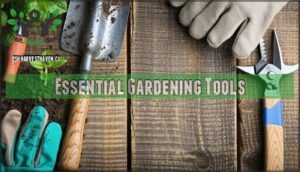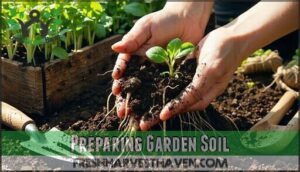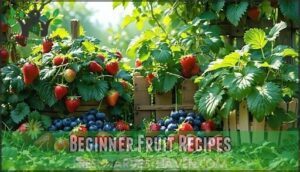This site is supported by our readers. We may earn a commission, at no cost to you, if you purchase through links.
 You don’t need a massive garden or chef skills to master garden to table recipes for beginners.
You don’t need a massive garden or chef skills to master garden to table recipes for beginners.
Start with easy-growing crops like lettuce, tomatoes, and herbs that practically cook themselves into delicious meals. Your first harvest might feel like striking gold – there’s nothing quite like biting into a tomato that was hanging on the vine an hour ago.
Simple recipes work best: toss fresh basil with pasta, create colorful salads from mixed greens, or blend herbs into homemade pesto. The secret isn’t fancy techniques but timing your picking with your cooking.
Once you taste the difference fresh makes, you’ll discover why smart preservation methods can extend your garden’s magic year-round.
Table Of Contents
- Key Takeaways
- Garden Setup Basics
- Easy Garden Recipes
- Preserving Garden Produce
- Meal Planning Strategies
- Beginner Preservation Methods
- Frequently Asked Questions (FAQs)
- How do you prepare a garden for beginners?
- What to do with all my garden veggies?
- What can I make from my garden?
- How do I start composting at home?
- What tools are essential for novice gardeners?
- How to identify and fix soil issues?
- Which garden plants require little maintenance?
- How to balance flavors using garden herbs?
- When to harvest vegetables for optimal flavor?
- How to manage garden pests naturally?
- Conclusion
Key Takeaways
- You don’t need a massive garden or fancy equipment to start – just basic tools, good soil prep, and easy-growing crops like lettuce, tomatoes, and herbs will transform your small space into a fresh food goldmine.
- Simple recipes work best with garden-fresh produce – toss fresh basil with pasta, create colorful salads from mixed greens, or blend herbs into homemade pesto, letting the natural flavors shine without complicated techniques.
- Smart meal planning around your harvest timing prevents waste and creates organized weeks of eating – track your crop rotation, build recipe flexibility into your plans, and learn proper storage methods to bridge seasonal gaps.
- Preserve your garden’s bounty through simple methods like freezing, pickling, and making jams – these techniques extend your harvest’s magic year-round while saving money and providing homemade treats.
Garden Setup Basics
You don’t need a huge backyard or fancy equipment to start your garden-to-table journey.
Small spaces, big harvests—your windowsill herb garden can feed your family fresh flavors all season long.
With just a few basic tools, good soil prep, and the right crop choices, you’ll be amazed how quickly your small plot transforms into a fresh food goldmine that’ll make your neighbors green with envy.
Choosing Right Crops
Starting your first garden feels like opening a treasure chest of possibilities. You’ll want to pick crops that practically grow themselves while delivering fresh produce for your beginner garden recipes.
Climate considerations and space availability should guide your choices, ensuring your garden to table dreams become delicious reality. One of the best parts is that gardening boosts mental health by reducing stress and promoting mindfulness.
- Tomatoes – These garden superstars thrive in most climates and provide endless fresh ingredients for countless recipes
- Lettuce and leafy greens – Quick 30-day harvest timing means you’ll enjoy garden fresh salads all season long
- Radishes – The speediest growers that boost your confidence while requiring minimal soil requirements
- Snap peas – Low-maintenance climbers with natural pest resistance that kids love eating straight from the vine
- Zucchini – Prolific producers that’ll have you sharing surplus with neighbors and experimenting with creative beginner recipes
Essential Gardening Tools
You’ll need just four basic tools to start your garden-to-table journey.
A sturdy trowel, comfortable gloves, watering can, and pruning shears are your gardening arsenal.
Choose ergonomic tools that fit your hands well—trust me, your back will thank you later!
Don’t forget a soil testing kit to check nutrients.
A quality trowel matters for planting seedlings.
Proper tool maintenance keeps everything sharp and ready for harvesting garden fresh ingredients.
Preparing Garden Soil
Once you’ve got your tools ready, it’s time to get your hands dirty with soil prep. Think of soil as your garden’s foundation – you wouldn’t build a house on shaky ground, right?
Here’s your beginner gardening checklist for perfect soil preparation:
- Soil Testing – Test pH levels and nutrients with simple kits
- Drainage Solutions – Add sand or perlite for heavy clay soils
- Compost Importance – Mix in homemade or store-bought compost generously
- Organic Matter – Layer in fallen leaves, grass clippings, or aged manure
- Soil Amendments – Balance with lime for acidic soil or sulfur for alkaline
This gardening preparation transforms regular dirt into plant paradise. Remember that ideal pH is 6.0-7.0 for most vegetables. Your gardening guide starts with healthy soil – it’s like giving your vegetables a five-star hotel to grow in!
Easy Garden Recipes
You’ve got fresh vegetables growing in your garden, and now you’re ready to turn them into amazing meals that’ll make your taste buds dance.
These simple recipes transform your homegrown treasures into delicious dishes without fancy techniques or complicated ingredients, making it easy to create amazing meals.
Simple Herb Recipes
Fresh herbs transform ordinary meals into culinary masterpieces with minimal effort.
You’ll create restaurant-quality Herb-infused Oils by steeping basil in olive oil, or whip up savory Herb Butter Recipes mixing chives with softened butter.
Try invigorating Herbal Tea Blends using mint from your garden.
These simple garden recipes prove that easy garden cooking starts with herb-based sauces and Fresh Herb Salads. Experimenting with ideal herb pairings can substantially enhance the flavor of your dishes.
Delicious Vegetable Meals
When your garden overflows with fresh veggies, you’ll want simple garden recipes that shine.
Turn your garden’s overflow into culinary magic with recipes that let fresh flavors steal the show.
Try roasted vegetable side dishes with olive oil and herbs, or whip up quick veggie recipes like eggplant parmesan.
These garden to table recipes transform your harvest into satisfying vegetarian main courses.
Seasonal vegetable dishes never tasted so good, with simple recipes making all the difference.
Beginner Fruit Recipes
Your vegetable dishes are sorted, but let’s talk fruit magic.
Easy fruit salads take minutes to assemble with fresh strawberries and blueberries. Simple fruit desserts like rhubarb crumble satisfy any sweet tooth.
Beginner fruit smoothies blend garden treasures into creamy treats. Quick fruit snacks keep you energized, while baking with fruit creates summer recipes that’ll make neighbors jealous.
For small spaces, consider container gardening.
Preserving Garden Produce
You’ve grown more zucchini than your neighbors can handle, and your tomato plants are practically begging for mercy.
Don’t let that beautiful harvest go to waste when you can easily turn your garden’s bounty into delicious pickles, jams, and frozen treasures that’ll make winter meals taste like summer.
Creative Ways to Use Excess
When bumper crops threaten to overwhelm your kitchen, think beyond basic salads.
Transform wilted greens into fermented vegetable recipes that pack probiotics.
Toss herb stems into compost bins rather than trash—they’ll boost your soil.
Creative leftover dishes turn yesterday’s zucchini into today’s fritters.
Even unusual herb uses like basil ice cream can surprise guests while using excess harvest effectively.
Preserving Techniques
When your harvest overflows, smart food preservation keeps flavors alive year-round.
Freezing produce locks in 90% of nutrients while canning extends shelf life up to 18 months.
Try pickling onions for tangy crunch or drying herbs using your oven. Dehydrating methods remove moisture to prevent spoilage.
Water bath canning works well for high-acid fruits. These homemade preserves transform excess into pantry gold.
Making Jams and Jellies
Sweet success awaits when you master homemade preserves.
Strawberry jelly and blueberry jelly shine with natural pectin sources like apples.
Sugar alternatives work perfectly for healthier options.
Achieving proper jam consistency takes practice, while jelly clarity comes from careful straining.
Consider recipe ingredient options for unique flavor combinations.
Your jam making adventures will reward you with perfect storage methods that keep flavors bright all year, and proper jam consistency is key to enjoying your homemade preserves.
Meal Planning Strategies
You’ll discover that smart meal planning turns your garden’s unpredictable bounty into organized, delicious weeks of eating.
Think of it as your kitchen’s GPS system, guiding you from "What do I do with fifteen zucchini?" to "I’ve got dinner covered for the next three days!
Adapting to Seasonal Harvest
Planning your meals around what’s actually growing in your garden feels like solving a delicious puzzle.
Your harvest timing determines what hits your dinner table, making recipe flexibility your best friend.
Here’s how to master seasonal eating:
- Track your crop rotation schedule to predict upcoming harvests
- Create backup garden to table recipes for unexpected bumper crops
- Learn storage strategies that bridge seasonal gaps
- Master beginnerfriendly recipes using whatever’s ready now
Storing Fresh Produce
Proper vegetable storage turns your garden bounty into lasting meals.
Understanding ideal conditions for each crop maximizes shelf life while preserving freshness.
Some vegetables need cool, humid environments, while others prefer room temperature.
The ripening process and ethylene gas production affect storage decisions.
Smart food storage techniques keep your fresh produce storage systems working efficiently.
| Vegetable Type | Storage Method |
|---|---|
| Leafy Greens | Refrigerate in perforated bags |
| Root Vegetables | Cool, dark pantry storage |
| Tomatoes | Counter until ripe, then refrigerate |
| Herbs | Water glass method or freeze |
Planning Meals Around Yield
Your garden harvest shouldn’t catch you off guard. Smart meal planning means turning unpredictable yields into delicious opportunities. When life gives you twenty zucchinis, make zucchini everything!
- Track your garden inventory weekly to spot abundance early
- Build recipe flexibility into your meal plans with substitute-friendly dishes
- Practice yield forecasting by learning your plants’ production patterns
- Create seasonal adaptations of favorite recipes using whatever’s ready
- Minimize food waste through creative garden to table cooking strategies
Beginner Preservation Methods
You’ll love turning your garden bounty into delicious preserved foods that last for months.
These simple methods like pickling, freezing, and making jams will save you money and give you homemade treats all year long.
Canning and Pickling
Before diving into preserving, you’ll need proper Canning Equipment like pressure canners and sterilized jars.
Pickling Safety starts with understanding Acid Levels—pickled white onions, mustard pickles, and bread and butter pickles require specific vinegar ratios.
Fermented Vegetables develop naturally through controlled bacteria growth. Sweet pickles offer beginner-friendly preservation with extended Shelf Life when processed correctly.
To prevent botulism, pressure canning procedures are essential for low-acid foods.
Freezing and Dehydrating
Your freezer becomes your garden’s best friend when harvest time overwhelms your kitchen.
Freezing vegetables like corn on the cob locks in peak flavor for months.
Dehydrating fruits and herbs preserves their essence while extending shelf life dramatically.
A dehydrator machine purchase can substantially speed up this process.
Try air-drying fresh herbs in paper bags or using your oven for quick results.
These simple food storage methods transform abundance into year-round treasures.
Making Sauces and Relishes
Transform your bumper harvest into flavor-packed condiments that’ll make store-bought versions seem bland.
Garden-Fresh Salsas burst with just-picked tomatoes, while Herb-Infused Oils capture summer’s essence in every drop.
Whip up Spicy Pepper Relish for sandwich kick, master Tomato Sauce Basics for pasta nights, or create exotic Fruit-Based Chutneys.
These homemade treasures turn ordinary meals extraordinary using your fresh ingredients.
Frequently Asked Questions (FAQs)
How do you prepare a garden for beginners?
Think of soil as your kitchen countertop—it needs prep work first.
You’ll want to clear weeds, test soil pH, add compost, and choose easy plants like tomatoes and lettuce for guaranteed beginner success.
What to do with all my garden veggies?
You’ve got options! Make quick pickles with cucumbers, freeze corn for winter meals, dehydrate herbs for seasoning, or whip up fresh salads.
Preserve excess through canning, share with neighbors, or try new recipes daily.
What can I make from my garden?
Sarah’s overflowing tomato plants inspired her first homemade salsa adventure.
You can create chile rellenos, eggplant parmesan, cucumber salads, or herb-infused drinks.
Your garden’s bounty transforms into fifteen quick recipes ready in thirty minutes, making it a great way to enjoy your garden’s bounty.
How do I start composting at home?
Start with kitchen scraps like banana peels, coffee grounds, and eggshells.
Add brown materials such as dried leaves or shredded paper.
Turn weekly, keep moist, and you’ll have rich soil amendment in months!
What tools are essential for novice gardeners?
Most gardeners waste money on unnecessary tools initially.
You’ll need just four basics: a sturdy trowel for digging, quality gloves for protection, a reliable watering can, and sharp pruning shears for trimming—that’s your complete starter toolkit.
This toolkit includes the essentials for any beginner, providing a solid foundation for gardening tasks.
How to identify and fix soil issues?
Test your soil’s pH with a simple kit from any garden center. If it’s too acidic, add lime. Too alkaline? Mix in sulfur. Compacted dirt needs compost worked in deeply.
Which garden plants require little maintenance?
You’ll love growing lettuce, radishes, and herbs like basil.
They’re practically foolproof! Tomatoes and green beans also thrive with minimal fuss.
These hardy plants forgive beginner mistakes while delivering fresh flavors straight to your kitchen table, making them hardy plants.
How to balance flavors using garden herbs?
You’ll create perfect herb harmony by adding delicate ones like basil last, using bold herbs like rosemary sparingly, and tasting frequently.
Fresh herbs pack more punch than dried, so start small and build up gradually.
When to harvest vegetables for optimal flavor?
Pick most vegetables in early morning when they’re crisp and sugar levels peak.
Harvest tomatoes when they’re fully colored but still firm, and leafy greens before the day’s heat wilts them.
How to manage garden pests naturally?
Like knights defending their castle, beneficial insects patrol your garden kingdom.
You’ll attract ladybugs with marigolds, spray soapy water on aphids, and companion plant basil near tomatoes.
Nature’s army protects your harvest naturally.
Conclusion
Ironically, the hardest part about garden to table recipes for beginners isn’t growing the food—it’s resisting the urge to eat everything straight from the plant.
You’ve learned that simple techniques create extraordinary meals.
Fresh herbs transform basic pasta into restaurant-quality dishes. Your homegrown tomatoes make store-bought ones taste like cardboard.
Start small, harvest often, and don’t overthink it. Soon you’ll wonder how you ever cooked without your own backyard ingredients fueling every delicious meal.
- https://garden.org/special/pdf/2014-NGA-Garden-to-Table.pdf
- https://www.ucihealth.org/blog/2022/09/delicious-garden-to-table-recipes
- https://growingourgarden.com/garden-to-table/
- https://gardensgrown.com/garden-to-table-cookbook/
- https://www.gardeningknowhow.com/edible/vegetables/how-to-grow-garden-to-table












